Riga Touristic Information
Riga, the vibrant capital of Latvia, seamlessly blends centuries of history with a modern European charm. Nestled along the Baltic Sea, its UNESCO-listed Old Town boasts a stunning array of architectural treasures, from medieval churches to art nouveau masterpieces, showcasing its rich cultural heritage. The city pulses with a dynamic energy, evident in its bustling markets, trendy cafes, and lively nightlife scene. Riga's green spaces offer tranquil retreats amidst the urban bustle while the Daugava River winds gracefully through the cityscape. With a thriving arts scene, diverse cuisine, and welcoming locals, Riga exudes a captivating allure that beckons visitors to explore its enchanting streets and soak in its unique atmosphere.
Old Town (Vecrīga): the heart of Riga's historic district is characterized by narrow cobblestone streets, medieval architecture, and charming squares. Key landmarks include Riga Castle, Riga Cathedral, St. Peter's Church, and the iconic House of the Blackheads.

Panorama of Riga. Photographer Leon Balodis. Source: www.enciklopedija.lv
Art Nouveau Architecture: Riga boasts one of the largest collections of Art Nouveau architecture in the world. The district around Albert Street is particularly famous for its ornate facades and intricate decorations.
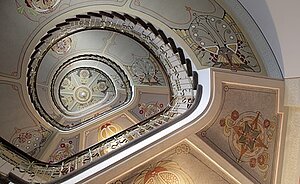
Photo source: www.jugendstils.riga.lv
Central Market (Centrāltirgus): housed in five former airship hangars, Riga's Central Market is one of the largest and most diverse markets in Europe. Visitors can explore stalls selling everything from fresh produce, fish, and meats to clothing and handicrafts.
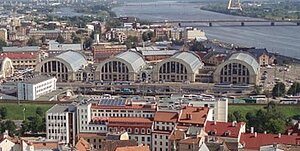
Photo author: David Holt (uploaded and derivative work: MrPanyGoff). Source: www.wikipedia.org
Freedom Monument (Brīvības piemineklis): this iconic monument stands in honor of Latvia's independence and is one of the city's most recognizable landmarks.
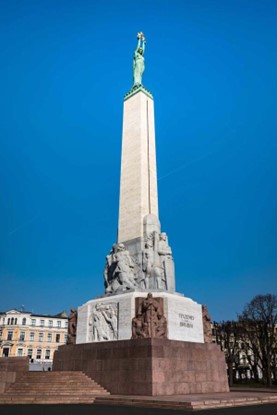
Photo source: Distinctive Shots/Shutterstock.com
Museum of the Occupation of Latvia: this museum provides insight into Latvia's turbulent 20th-century history, particularly the periods of Nazi and Soviet occupation.
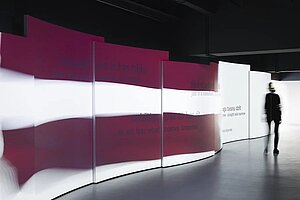
Photo author: Ansis Starks. Source: www.liveriga.com
Latvian National Opera and Ballet: visitors can attend opera, ballet, and other performances at this stunning Neo-classical theater. The tickets can be purchased online.
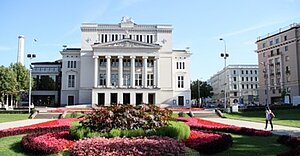
Photo source: www.opera.lv
Āgenskalns Market (Āgenskalna tirgus): Āgenskalns is a Riga neighborhood. Situated on the left bank of the Daugava River, the same bank as the LUMDETR 2024 conference venue. The neighborhood has a rich history, with some of its buildings dating back to the late 19th and early 20th centuries. It was one of the first areas outside of the Old Town to be developed, and it retains much of its historic architecture. Āgenskalns Market has been open since 1898. It is the largest and oldest market on the left bank of the Daugava River and holds the status of a national cultural monument. After a stroll along the tranquil streets of Āgenskalns, you deserve to enjoy a meal and a drink in the lively atmosphere.
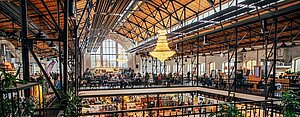
Photo source: www.agenskalnatirgus.lv
Day trip to Jūrmala: Riga serves as a convenient base for exploring Latvia's picturesque coastal town, Jūrmala. You can hop on a train at the Riga Central Station and, after a half-hour’s trip, get off in Majori, part of Jūrmala —a popular seaside resort town on the Gulf of Riga. Jūrmala itself is known for its sandy beaches, pine forests, and charming wooden architecture, making it a favored destination for tourists seeking relaxation and natural beauty.
Majori is one of the central parts of Jūrmala and serves as one of its main commercial and cultural hubs. It features a bustling pedestrian street lined with shops, cafes, restaurants, and art galleries, creating a vibrant atmosphere, especially during the summer.
In addition to its lively commercial scene, Majori boasts several landmarks and attractions. The Majori beach is one of the most visited spots, offering visitors a chance to enjoy the sun, sea, and sand.
Even though Majori is the central part of Jūrmala, the beach is also within walking distance if you get off the train in Bulduri, Dzintari, Dubulti, Jaundubulti, Pumpuri, Melluži or Vaivari.
You can check the train timetables and buy tickets here.
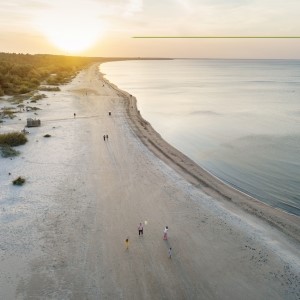
Photo source: www.visitjurmala.lv
Weather conditions
In June, Riga typically experiences mild to warm weather conditions. The climate in Riga during this time of year is influenced by its location in the Baltic region (the weather conditions are hard to predict for a longer period of time). Generally, you can expect:
Temperature: daytime temperatures in June usually range from around 15°C to 25°C. However, temperatures can occasionally climb higher, reaching into the upper 20°C. Nighttime temperatures tend to be cooler, dropping to around 10°C to 15°C.
Sunshine: June in Riga typically sees long daylight hours (over 17 hours), with the sun rising early and setting late.
Rain: while June is generally a drier month compared to the wetter months of spring, occasional rain showers are still possible. Packing an umbrella or a light rain jacket, just in case, is advisable.
Remember that weather can vary from year to year, so it's always a good idea to check a reliable weather forecast closer to your travel dates for the most accurate information.